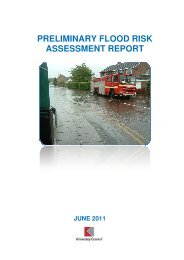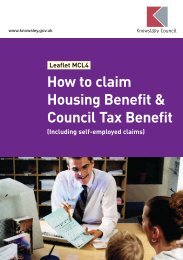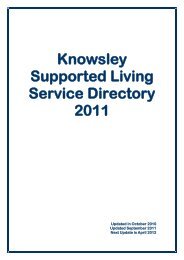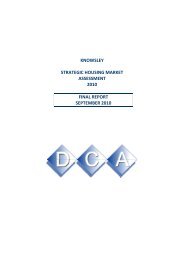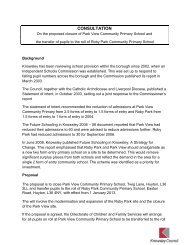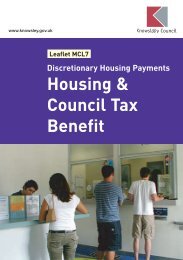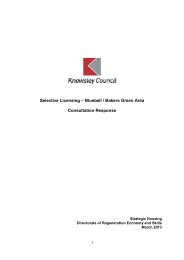Knowsley Replacement Unitary Development Plan - Knowsley Council
Knowsley Replacement Unitary Development Plan - Knowsley Council
Knowsley Replacement Unitary Development Plan - Knowsley Council
Create successful ePaper yourself
Turn your PDF publications into a flip-book with our unique Google optimized e-Paper software.
ENVIRONMENTAL PROTECTION AND NATURE CONSERVATION<br />
ENVIRONMENTAL PROTECTION AND NATURE CONSERVATION<br />
POLICY ENV2:<br />
NOISE AND VIBRATION<br />
1. <strong>Development</strong> that will either cause an<br />
unacceptable increase in noise or vibration<br />
levels or itself be subject to unacceptable<br />
noise or vibration from an existing source will<br />
not be permitted.<br />
2. Where developments are permitted, conditions<br />
may be attached to the planning permission to<br />
ensure effective noise insulation or other<br />
required mitigation measures are carried out.<br />
EXPLANATION ENV2<br />
13.15<br />
Noise problems can be created when proposals for<br />
noise generating development would be located near<br />
to existing noise sensitive uses such as housing,<br />
hospitals and schools. Areas that are considered<br />
tranquil (e.g. parts of the countryside or urban<br />
greenspace areas) should also be considered as<br />
noise sensitive and preserved for their amenity value.<br />
Conversely, problems can also be experienced where<br />
proposals for sensitive uses such as new housing<br />
would be located close to existing factories, roads or<br />
other existing sources of noise.<br />
PROCEDURES<br />
13.16<br />
Problems can be avoided by ensuring adequate<br />
separation distances between sensitive uses and<br />
sources of noise or vibration. Where a development<br />
would be likely to generate significant levels of noise,<br />
or be sensitive to an existing noise source, the<br />
<strong>Council</strong> will require that a noise assessment report<br />
be submitted as part of the planning application.<br />
The proposals will also need to incorporate any<br />
necessary measures to reduce noise or disturbance<br />
to acceptable levels. Noise control measures such as<br />
earth mounds or fencing should be designed so that<br />
they are as visually attractive as possible (including<br />
sensitive design and siting and an appropriate degree<br />
of landscaping). Further guidance on noise<br />
assessments can be found in <strong>Plan</strong>ning Policy<br />
Guidance Note 24 “<strong>Plan</strong>ning and Noise”.<br />
POLICY LINKS<br />
Policy H5<br />
“<strong>Development</strong> within Primarily Residential Areas”<br />
Policy G2<br />
“Landscape Character and Amenities of the Green<br />
Belt”<br />
Policy OS2<br />
“Urban Greenspace”<br />
Policy DQ1<br />
“Design Quality in New <strong>Development</strong>”<br />
POLICY ENV3:<br />
LIGHT POLLUTION<br />
1. <strong>Development</strong> requiring external lighting must<br />
satisfy the following criteria:<br />
a) The lighting scheme proposed is the<br />
minimum required for security and<br />
working purposes to undertake the task;<br />
b) There would be no unacceptable impact on<br />
visual amenity in the surrounding area;<br />
c) The scheme will not have an unacceptable<br />
effect on road safety;<br />
d) The scheme will not harm wildlife; and<br />
e) There will be no unacceptable loss of<br />
residential amenity.<br />
EXPLANATION ENV3<br />
13.17<br />
The lighting of developments is important for security<br />
and safety reasons. However, different forms of<br />
lighting, from street lighting to security lighting,<br />
increasingly and unnecessarily pollute today’s<br />
environment. Poorly designed or badly aimed lights<br />
that are responsible for “sky-glow” can have<br />
detrimental effects on wildlife, astronomical<br />
interests, highway safety and reduce the feeling of<br />
remoteness in rural areas. The <strong>Council</strong> may in some<br />
cases use conditions to require that lighting is<br />
orientated away from residential properties or from<br />
nearby amenity or countryside areas.<br />
13.18<br />
<strong>Plan</strong>ning applications for development should be<br />
accompanied by details of any lighting schemes<br />
proposed to allow assessment of any likely impact.<br />
POLICY LINKS<br />
Policy H5<br />
“<strong>Development</strong> within Primarily Residential Areas”<br />
Policy T12<br />
“Aerodrome Safeguarding”<br />
Policy G2<br />
“Landscape Character and Amenities of the Green<br />
Belt”<br />
Policy OS2<br />
“Urban Greenspace”<br />
POLICY ENV4:<br />
HAZARDOUS SUBSTANCES<br />
1. <strong>Development</strong> which involves the use or storage<br />
of hazardous substances, including<br />
modifications to existing establishments, will<br />
not be permitted if it would cause unacceptable<br />
risk to the users of the site, surrounding land<br />
users or the environment.<br />
2. <strong>Development</strong> within the consultation zones<br />
around existing hazardous installations or<br />
pipelines will only be permitted if:<br />
a) The level of risk to occupiers, visitors or<br />
users of the proposed development is<br />
considered acceptable; or<br />
b) The proposal includes measures that will<br />
mitigate the likely risks to the<br />
surrounding population.<br />
EXPLANATION ENV4<br />
13.19<br />
A fundamental aim of this policy is to prevent major<br />
accident hazards and limit the consequences of such<br />
hazards. Certain sites and pipelines are designated<br />
as hazardous installations by virtue of the quantities<br />
of hazardous substance present. The siting of such<br />
installations is subject to planning controls, for<br />
example under the <strong>Plan</strong>ning (Control of Major<br />
Accident Hazards) Regulations 1999. The objective in<br />
operating these controls is to maintain appropriate<br />
distances between establishments and residential<br />
areas, areas of public use and areas of particular<br />
sensitivity or interest. The <strong>Council</strong> will consult the<br />
Health and Safety Executive (HSE) about any<br />
proposals to site new hazardous installations, or to<br />
modify existing installations, within <strong>Knowsley</strong>.<br />
13.20<br />
The Borough of <strong>Knowsley</strong> already contains a number<br />
of hazardous substances establishments and major<br />
accident hazard pipelines. Whilst they are subject to<br />
stringent controls under existing health and safety<br />
legislation, it is considered prudent to control the<br />
kinds of development permitted in the vicinity of<br />
these installations. The HSE has advised the <strong>Council</strong><br />
on consultation distances for each of these<br />
installations. In determining whether or not to grant<br />
planning permission for a proposed development<br />
within these consultation distances the <strong>Council</strong> will<br />
consult the HSE about risks to the proposed<br />
development from the hazardous installation.<br />
POLICY LINKS<br />
Policy EC3<br />
“Primarily Industrial Areas”<br />
154<br />
KNOWSLEY REPLACEMENT UNITARY DEVELOPMENT PLAN: Adopted June 2006<br />
KNOWSLEY REPLACEMENT UNITARY DEVELOPMENT PLAN: Adopted June 2006<br />
155



